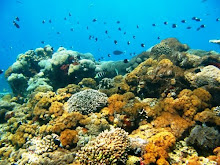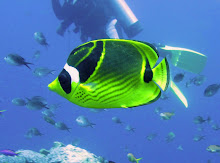Pemerintah Kabupaten Klungkung tengah menyusun konsep cetak biru Kawasan Konservasi Laut (KKL) di sekitar perairan Nusa Penida, sebuah pulau di selatan Pulau Bali ini. Jika KKL terwujud, diharapkan mengurangi pencurian ikan, konservasi terumbu karang, peningkatan kualitas wisata bahari, dan pemberdayaan masyarakat setempat.
Hal ini dibahas dalam workshop soal pembentukan KKL oleh sejumlah stakeholder Kabupaten Klungkung, yang mewilayahi Nusa Penida, Rabu (10/9) lalu. Difasilitasi The Nature Conservacy (TNC), NGO yang bergerak di bidang lingkungan, sejumlah pejabat Klungkung dari Dinas Lingkungan Hidup, Badan Pembangunan Daerah (Bapeda), Kecamatan Nusa Penida, dan lainnya menggali potensi Nusa Penida sebagai kawasan konservasi laut.
Selama ini diakui pemerintah daerah, Nusa Penida belum mempunyai konsep pengelolaan perairan yang integral. ”Selama ini kegiatan dilakukan parsial saja. Melihat perkembangan wisata yang makin tinggi dan permasalahan penangkapan ikan berlebihan, maka kawasan konservasi laut sangat penting,” ujar Anak Agung Ngurah Kirana, Kepala Bidang Ekonomi Bapeda Klungkung.
Kawasan Konservasi Laut (KKL) telah terbukti menjadi alat yang efektif untuk perlindungan keragaman hayati laut dan pengelolaan pemanfaatan sumberdaya yang lestari, khususnya untuk perikanan dan pariwisata. Keberhasilan pengelolaan KKL juga berdampak nyata pada peningkatan kunjungan wisata yang berdampak langsung pada perekonomian lokal.
KKL tersusun dari beberapa zona peruntukkan dalam usaha mengakomodasi berbagai tingkatan pemanfaatan sumber daya di setiap zona. Zona larang-ambil (no-take zone), yang masih bisa dimanfaatkan untuk kegiatan pariwisata, memberikan perlindungan yang baik bagi sumbe rdaya ikan dan sangat diperlukan sebagai penyedia sumber ikan bagi daerah penangkapan di sekitarnya.
Zona ini juga memberikan perlindungan terhadap keanekaragaman sumberdaya hayati. Zona lainnya dalam KKL memungkinkan memperbolehkan pengambilan sumberdaya dengan alat yang tidak merusak habitat organisme laut dan melalui perijinan yang diatur dengan prinsip daya dukung sumberdaya.
Perairan Nusa Penida dinilai salah satu contoh lokasi yang sangat unik dan tepat untuk dijadikan Kawasan Konservasi Laut. Nusa Penida terletak pada batas barat-selatan segi-tiga karang dunia (Coral Triangle) yang sering diartikan sebagai pusat keanekaragaman sumber daya hayati laut di bumi.
”Keberadaan ikan mola-mola dan manta merupakan dua jenis keanekaragaman sumber daya hayati unik dan langka yang perlu mendapat penanganan serius. Ikan ini menjadi favorit para penyelam dunia dan sangat sulit dijumpai di perairan lain,” ungkap I Dewa Gede Raka Wiadnya, peneliti lingkungan TNC-Coral Triangle Center.
Sebagian besar pantai Nusa Penida dimanfaatkan sebagai ladang budi daya rumput laut yang pernah menjadi sumber utama mata pencaharian masyarakat setempat. Selain itu, kini Nusa Penida juga berkembang sebagai pusat kegiatan pariwisata pantai dan laut di Bali. Akomodasi dari berbagai kepentingan ini sangat sesuai untuk disatukan dalam bentuk perencanaan Kawasan Konservasi Laut untuk melindungi sumber mata pencaharian masyarakat.
Ancaman kerusakan lingkungan perairan Nusa Penida harus diselamatkan. I Dewa Gede Tegeh Menala, salah seorang tokoh masyarakat setempat mengatakan saat ini banyak kapal besar semacam pukat harimau yang menangkap ikan di perairan Nusa Penida. ”Nelayan kecil seperti saya kalah jauh karena mereka menggunakan jaring yang sangat besar dan ini yang membuat penangkapan ikan berlebihan,” ujarnya.
Akibatnya, menurut Tegeh, sebagian besar nelayan di lima desa daerah pesisir Nusa Penida yang berprofesi sebagai nelayan banyak terlilit hutang pada rentenir. Para rentenir kini mengikat nelayan kecil dengan menyediakan perahu, jaring, sampai bahan bakar perahu. ”Pendapatan nelayan kecil karena harga tangkapan pun diatur rentenir,” tambah Tegeh.
Ia berharap KKL ini segera dapat diwujudkan dengan landasan hukum yang kuat. ”Saya punya cita-cita mengembangkan koperasi nelayan agar bisa terlepas dari rentenir,” pinta warga asal Desa Batununggul, Nusa Penida ini.
Nusa Penida berdekatan dengan dua pulau kecil yakni Nusa Lembongan dan Nusa Ceningan yang juga ramai dikunjungi turis. Banyak kapal pesiar kecil yang memanfaatkan potensi bahari perairan ini seperti Quick Silver, Bali Hai, dan Bounty Cruise. Ironisnya, Nusa Penida masih dianggap daerah miskin dan banyak warganya yang bekerja di luar daerah. Pertanian dan perkebunan setempat hanya mengandalkan tadah hujan karena kesulitan pasokan air.
Dengan dasar hukum UU No. 5/1990, pemerintah Indonesia telah menetapkan dan mengelola luas total KKL mencapai sekitar 5,6 juta ha. Pemerintah melalui Departemen Kelautan dan Perikanan bahkan menyatakan keinginan untuk menambah luas KKL di Indonesia mencapai 10 juta ha pada tahun 2010 dan 20 juta ha pada tahun 2020. [b]










